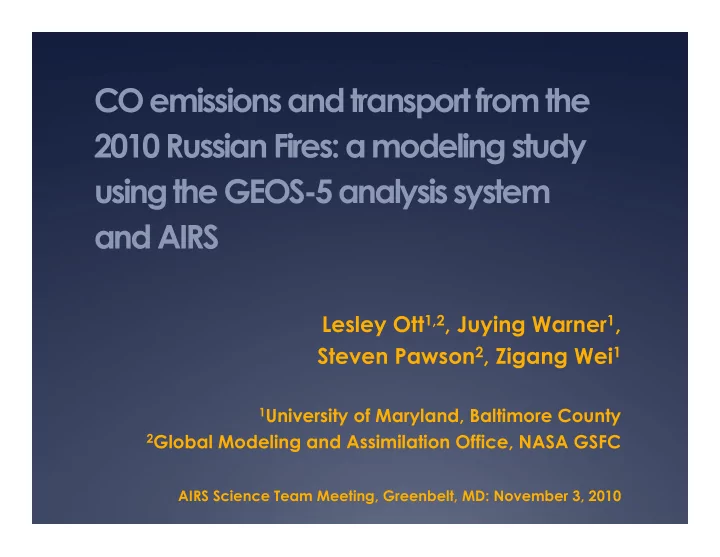

CO emissions and transport from the 2010 Russian Fires: a modeling study using the GEOS-5 analysis system and AIRS Lesley Ott 1,2 , Juying Warner 1 , Steven Pawson 2 , Zigang Wei 1 1 University of Maryland, Baltimore County 2 Global Modeling and Assimilation Office, NASA GSFC AIRS Science Team Meeting, Greenbelt, MD: November 3, 2010
Background In July and August, Russia experienced strong fire outbreaks near Moscow and in the Siberian region Emissions and transport of trace gases and aerosols were simulated online in near real time by the GEOS-5 modeling and assimilation system Meteorological analyses for 2010 produced at 0.5° resolution using the GEOS-5.2.0 system (same system used for MERRA) Wind, temperature, moisture, and ozone data are assimilated (CO and aerosol data are not assimilated) Sulfate, black carbon, organic carbon, dust, and sea salt aerosols using the GOCART model Linearized CO chemistry (specified OH fields) with tracers tagged by source and region Biomass burning emissions based on MODIS active fire detections
MODIS Rapid Response Team: Russian Fires on July 29, 2010 http://rapidfire.sci.gsfc.nasa.gov/gallery/?2010210-0729/Russia.A2010210.1005.1km.jpg
GEOS-5 CO modeling Includes emissions from fossil and biofuels, conversion from HCs (methanol, isoprene, methane, terpenes) Loss calculated using prescribed 3D monthly OH climatology Biomass burning emissions calculated from the Quick Fire Emission Database (QFED v.1) CO emission = const(lat,lon) x f c (lat,lon,time) Values of emission factors are tuned to ensure that global CO emissions match GFED-2 emissions Emissions distributed throughout PBL with dependence on pressure
Observed and Simulated 500 hPa CO mixing ratio – 7/20 GEOS-5 CO mixing ratios convolved with AIRS averaging kernels and compared with operational retrievals On 7/20, active fires are visible over Siberia Over Moscow, 7/20 is just before increase in fire activity Average over Moscow region indicates that GEOS-5 is biased high by ~25 ppbv
Observed and Simulated 500 hPa CO mixing ratio – 7/26 On 7/26, fire activity begins to increase north of Moscow GEOS-5 does a remarkable job of reproducing CO mixing ratios in the vicinity of Moscow In the burning region of Siberia and the area south of Moscow, CO is overestimated, likely due to excessive background CO
Observed and Simulated 500 hPa CO mixing ratio – 8/08 On 8/08, AIRS observes an intense fire plume extending east and north of Moscow along with weaker fire activity in Siberia GEOS-5 is able to reproduce the pattern of horizontal transport well, but continues to underestimate CO mixing ratios in the fire plume while overestimating background mixing ratios
Observed and Simulated 500 hPa CO mixing ratio – 8/19 Fire emissions have decreased and peak CO mixing ratios have moved east of Moscow. AIRS indicates CO mixing ratios in Moscow are near background levels. In GEOS-5, CO mixing ratios over Moscow remain elevated due to model high bias
High GEOS-5 In this period, the regional bias here is biomass-burning CO because of emissions need to be about fossil/biogenic 2.5-5 times higher emissions
Peat emissions – a missing source of CO in GEOS-5? Percent coverage of peatlands in Russia (Vompersky et al., 1999) Grassland Extratropical Peat Forest Emission factors in g species CO 61 106 210 per kg dry matter burned CO 2 1646 1572 1703 (van der Werf et al., 2010) CH 4 2.2 4.8 20.8
Summary Patterns of GEOS-5 CO distributions agree well with AIRS observations Comparison with AIRS CO reveals high bias in background CO mixing ratios over Europe Fossil fuel emissions in operational GEOS-5 products taken from 2000-2005 inventories are likely too high over parts of Europe Biogenic conversion factors in operational GEOS-5 system are larger than recommended by Duncan et al. (2007) Comparison with AIRS CO reveals low bias in CO mixing ratios during peak fire activity Smoke may obscure MODIS fire detections leading to underestimate of fire extent Emission factors may be too low if peat is not considered No fire persistence is assumed (emissions only on day of fire detection) Smoldering peat fires may be hard to detect from satellite
Current and future work Beginning to use year-specific fossil fuel emissions and lower HC CO conversion factors Testing new version of QFED – v2.1 based on fire radiative power which increases emissions from Russian fires by 25% and preliminary peat emissions calculated using fractional peat coverage and burned area estimates Evaluating sensitivity to assumptions of fire persistence and vertical distribution of fire emissions to develop revised emissions estimates for future modeling studies
Recommend
More recommend